Hi Everyone,
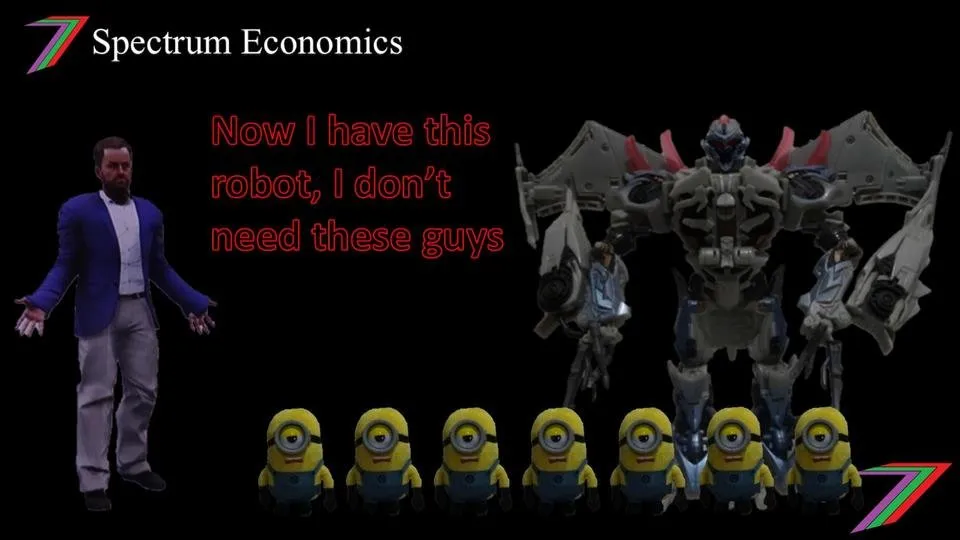
Note: This post supplements my post 'Technology – Curse or blessing?'
Job creation is described as an important objective of Government and society as a whole. Increasing efficiency is also described as important. Net job creation and improved efficiency could quite easily become competing objectives. Replacing jobs with automation could improve efficiency but reduce the number of jobs available. Creating new jobs unnecessarily would reduce efficiency if these jobs were not particularly productive.
A logical place for me to start this post would be to consider why both job creation and efficiency are important.
Importance of jobs

People contribute to society through jobs. These same people are then rewarded for their contributions. Creating jobs enables people to contribute more as well as obtain higher rewards. These rewards can be used to increase the standard of living of those that earned these rewards through their work. The output produced from the work should increase the standard of living of society as a whole. Having a job can also provide many other psychological and social benefits as well (not to be discussed in this post).
Number of jobs vs number of hours (efficiency)
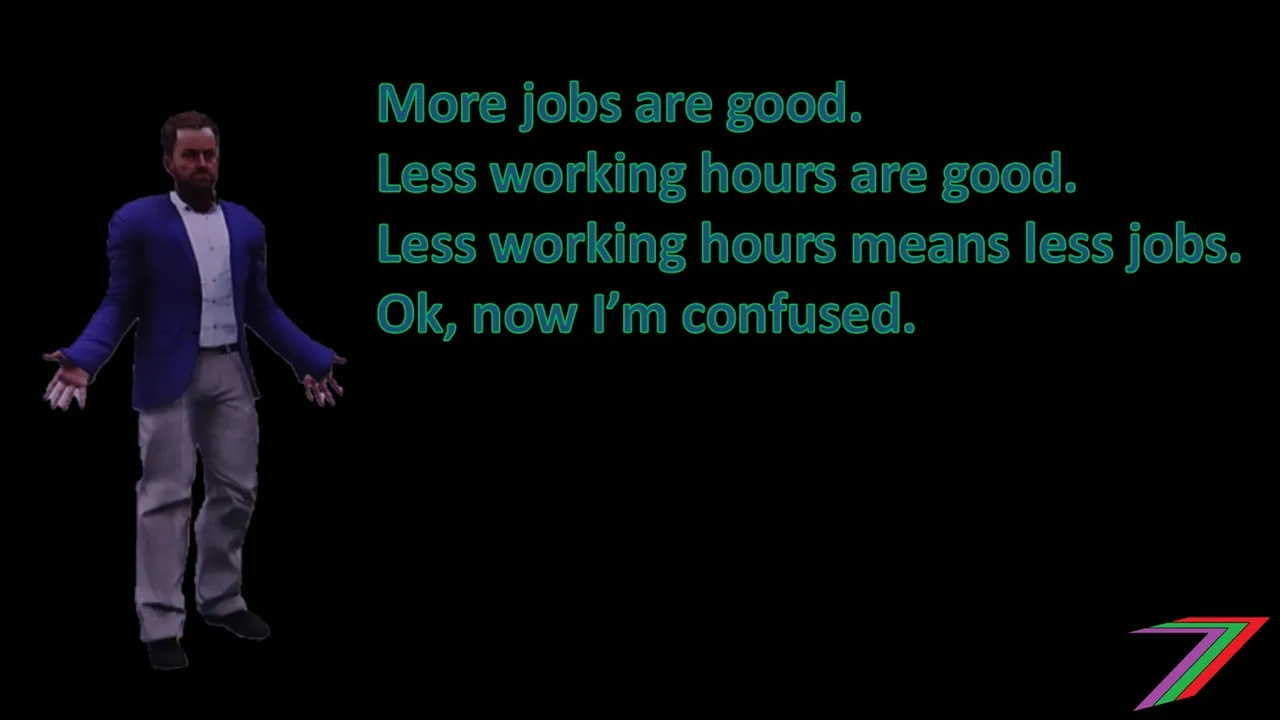
It is important to distinguish between number of jobs and number of hours worked. Efficiency is effected by the number of hours rather than the number of people employed. For example, one person could work 60 hours a week or 2 people could work 30 hours each or 3 people could work 20 hours each a week. Each of these combinations produces 60 working hours. However, the number of people employed is different. The efficiency from employing 1 or 3 workers for the same combined hours could vary depending on the nature of the work; efficiency does not necessarily increase from simply employing more people.
For example, the introduction of technology could reduce working hours by half. A company could respond by reducing the number of staff by half, reducing working hours of all staff by half or a combination of the two. Normally reducing the number of staff favours the company and reducing the number of hours favours the staff (assuming savings from the introduction of the technology is passed onto the staff).
Imagine one company provides all the jobs for a particular town (Monopsony). The company requires 12,000 labour hours a week. If the town has 400 people needing jobs, the company could employ everyone to work 30 hours a week. Each person would work 6 hours a day for five days a week (5×6=30).
The company could choose to hire just 300 people to work 40 hours a week; therefore, a 100 people would not have jobs. However, the working hours would be the same. This benefits the company as 400 people would be competing for 300 jobs. The competition for jobs would push wages down. The people in the town would be worse off as 100 people would be unemployed and those employed will need to work longer hours at possibly no higher pay.
The company could choose to hire just 200 people to work 60 hours a week; therefore, a 100 people would not have jobs. The competition for jobs would be even more intense as half the people will not be able to get jobs. This will place great pressure on wages. The 200 people that obtained the jobs would be working twice as long (60 instead of 30 hours) and may not be earning substantially higher incomes. The 200 people working have little negotiating power, as there are plenty of unemployed workers (200) able to replace them.
The company has incentive to hire less workers for longer hours to reduce wages. There is likely to be a limit to the number of hours required to work as quality of output can be expected to decrease with worker fatigue. The 996 work schedule (72 hour week) in China has faced criticise for its impact on health and productivity. Even a 40 hour week could be unproductive in the long-run (MSN.com).
Some numbers to think about
Table 1 contains the top 8 countries with the highest percentage of people working more than 60 hours a week. The table also contains GDP per capita (2018 data) and unemployment rate (data ranging from 2015 to 2018).
Table 1: Countries with the highest percentage of people working over 60 hours a week

(Source working hours: qz.com), (Source: unemployment: Wikipedia) and (Source GDP (PPP) per capita: imf.org)
South Korea was the only country in this table with a GDP per capita in the top 50 countries in the world. The world GDP per capita has been estimated at $16,779. Four countries in Table 1 have lower than the world figure.
The above examples have been described in the context of one employer and many employees (Monopsony). In reality, that is only sometimes true. The world has many markets. Some markets have one seller (i.e. monopoly), some have many sellers (i.e. monopolistic competition), and some have one buyer (i.e. monopsony).
Basic Example: Improving technology – Large firm vs. many small firms

To explain the impact of the number of firms on the distribution of benefits from improved efficiency, I describe a very basic example comparing a world with one firm with a world with many firms. To make the example extremely simple, I assume that the only good that anyone needs is widgets and that everyone is identical in terms of ability, personality, needs and wants (everyone only needs to consume their own output and trade is not necessary). Therefore, only widgets are ever produced. A person needs to consume a certain number of widgets to survive. Any additional widgets adds to quality of life up until a certain point (diminishing marginal utility). In this world, everyone needs at least 16 widgets a day to survive. Widgets continue to provide utility up until the 40th widget. For example, if a person has 60 widgets they will save at least 20 widgets to consume later (widgets are not perishable).
In this world, each person is able to produce 2 widgets an hour. To simplify further, let’s assume we have a constant population of 30 people. In the world with one firm, one person controls all factors of production. In the world with many firms (10), all people have equal holding of factors of production and everyone is an entrepreneurs.
One firm structure
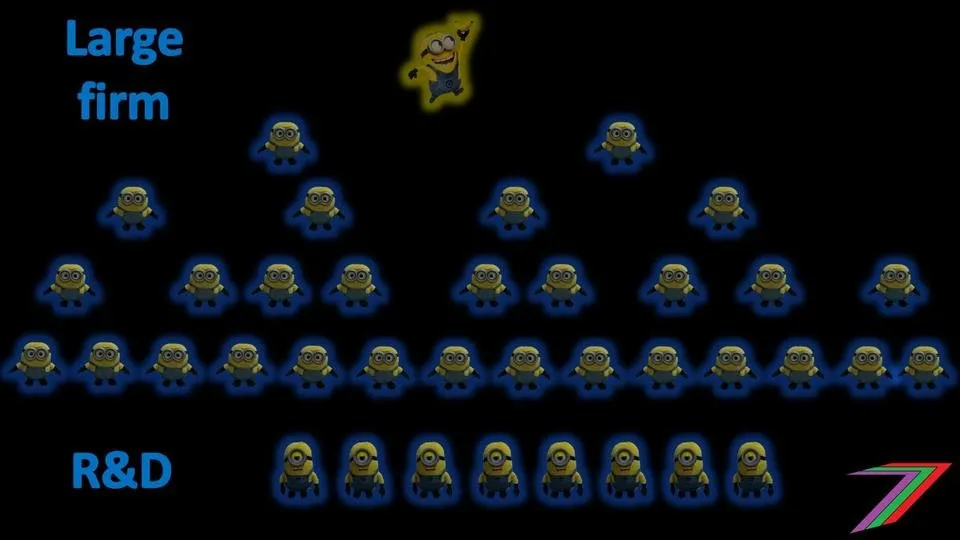
In the world with one firm, each person works 10 hours a day and collectively produce 600 widgets (20 widgets each for 30 people). Based on the structure in diagram above, 14 people receive 16 widgets (minimum), 9 people receive 18 widgets (incentive for more responsibility), 4 people receive 20 widgets (middle management), 2 people receive 24 widgets (upper management), and the owner receives 86 (consumes 40 and saves the rest).
In the world with many firms, each person also works 10 hours a day and collectively produce 600 widgets. Each person keeps the widgets he or she produces.
Many firm structure
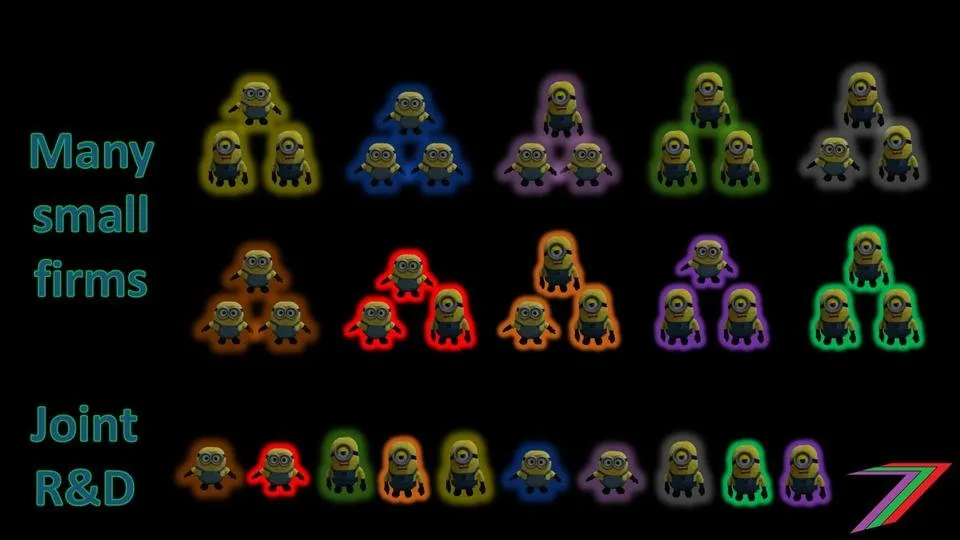
There is a possibility of improving efficiency by investing in a new technology. This technology will enable each person to triple his or her production per hour. However, this technology requires 800 hours to create.
In the world with one firm. The owner temporarily moves 8 people to research and development to build this new technology. These people will work 10 hours a day for 10 days. Their pay will increase from 16 widgets to 20 a day for that period. All other workers will receive the same pay as before. The owner will be 192 widgets (reduction in widget production + increase in pay = 8×20+8×4=192) worse off a day for the 10 days (1,920 widgets worse off). The owner will be required to use his own savings to cover some of the workers pay as well as his own consumption of widgets.
Once the technology is developed and implemented, previous arrangements regarding working hours and pay will be restored. Production of widgets has now increased from 600 to 1,800 a day. The owner will now receive 1,286 a day (consumes 40 and saves 1,246). In less than 2 days, the owner would be better off than prior to the development of the technology. Everyone else is no better off than before. The owner does not feel obliged to share the benefits of the improved efficiency as he invested the resources and bore the risk.
It is also possible that the owner does not feel he needs such an excessive number of widgets. In this case, the owner may decide to release 20 of the 30 workers. Therefore, the same number of widgets are being produced as prior to the introduction of the technology but only 10 workers are require to be paid. This is unemployment created from the acquisition of the improved technology.
In the world with many firms, the technology could also be developed. However, the costs would be too high for one or even two firms to invest in the new technology. Therefore, the firms will either cooperate to develop or acquire the technology or miss out. In the example given, cooperating to obtain the technology is by far the better strategy and offers the highest potential rewards.
Each firm could offer one person to help develop the technology, that person could dedicate half his or half his or her time to manufacturing widgets and half to the developing the technology. If each person still works 10 hours a day, each firm will produce 50 widgets (2×20+10=50). The two people remaining with the firm could take 16 widgets each and the remaining 18 widgets could go to the person helping developing the technology (1 extra widget to cover time spent transitioning to the new job). Therefore, 50 hours a day would be dedicated to developing the new technology. If we assume the technology still requires 800 hours to develop, it will be developed in 16 days.
Once the technology is implemented, the people working in the small firms could choose to still work 10 hours a day and allocate 60 widgets per a person or they could work less hours. For example, the firms may decide that 30 widgets per person is preferable and each person would only work 5 hours a day. This will give each person 10 more widgets and 5 more hours to enjoy the widgets than prior to the introduction of the technology.
Conclusion based on example
In a world with one firm or possibly many large firms. The owners of the firms will reap most of the benefits of technology. This can come in the form of higher output and/or lower costs of production. The workers may only benefit from a slight increase in pay, while many others could lose their jobs.
In a world with many small firms. The owners also reap the most benefits but there are more owners and many owners are the workers. Improved technology can benefit everyone. For this scenario to be successful requires cooperation between the firms to acquire the technological improvements as individual firms are most likely too small to obtain the required resources to make such investments by themselves.
Different types of jobs

The introduction of technology or any other changes that bring about an improvement in efficiency may not improve the efficiency of the existing workforce but require a workforce with a different skillset. It is possible that the existing workforce can simply upgrade their skills. It is also possible that many in the existing workforce will be unable to do so. In the case of the latter, the existing workforce will be replaced be a workforce with the necessary skills and the existing workforce will either be out of work or acquire jobs more compatible with their skillset.
In a world dominated by large firms, the number of people that could be replaced by a change in technology could be very high and very sudden. For example, in 2018, Wells Fargo (Financial Services Company) announced they would lay off 10% of their staff over a three-year period (26,500 jobs). This is mostly because of the company’s shift to online banking services (moneywise.com).
Textile company Raymond, plan to reduce their workforce by about 10,000. Robots and technology will replace these workers. The number of people required to operate the technology is considerably less than having manual factory workers (economictimes.indiatimes.com).
In a world with many small firms, the number of layoffs from the introduction of technology would be more gradual as each firm can operate independently to each other. This sounds great in theory but can small firms successfully operate in markets where technology is most likely to be introduced. Large firms often exist because of the opportunity to exploit economies of scale. For small firms to be able to exploit economies of economies they will need to cooperate. They will need to share resources and ideas. Whenever cooperation is required to succeed there is also opportunity to exploit particular situations. For small firms to cooperate successfully requires trust. This can be achieved through long-term working relationships or even from an established culture of cooperation. The success of the Lumezzane Valley businesses is a good example of shared success through cooperation (theblog.luxxdesign.com).
Conclusion
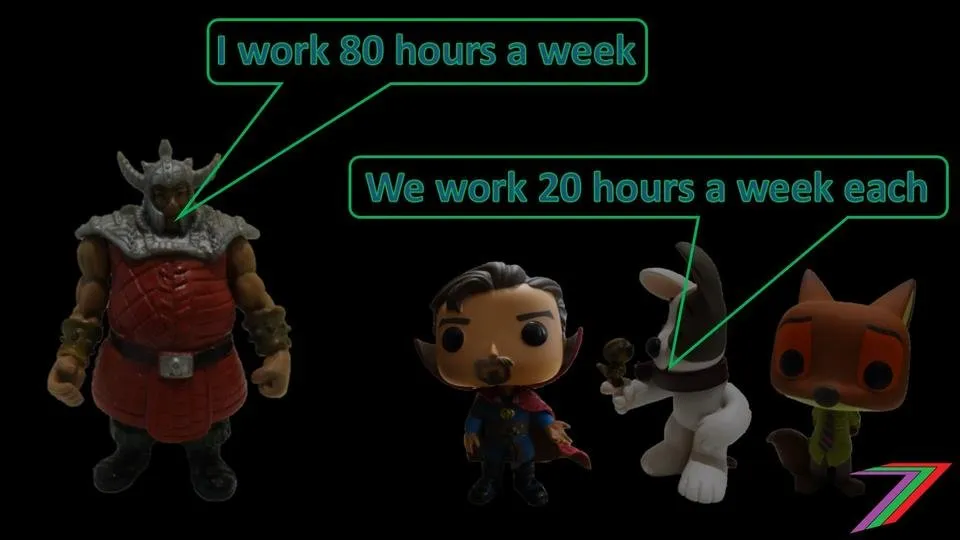
It is important to distinguish between the creation of jobs and the creation of working hours. Technology should reduce the number of hours required to perform work that is necessary to improve the quality of life. Working hours can be reduced by reducing the average number of hours worked per person, the number of people working or a combination of the two. It is also possible that jobs requiring long hours are replaced by different jobs with shorter working hours.
It is possible to create more jobs and reduce unemployment while improving efficiency and quality of life. This is more likely to be obtainable if the benefits of technology are distributed across more people. The benefits can be distributed across more people if more people are involved in the investment of technology. Many small firms investing compared to just a few large firms could help with that distribution. Those investing in the technology have the greatest say in how the benefits of that technology are distributed.
More posts
If you want to read any of my other posts, you can click on the links below. These links will lead you to posts containing my collection of works. These posts will be updated frequently.




Steem - The Future of DApps




